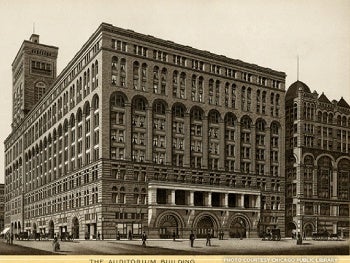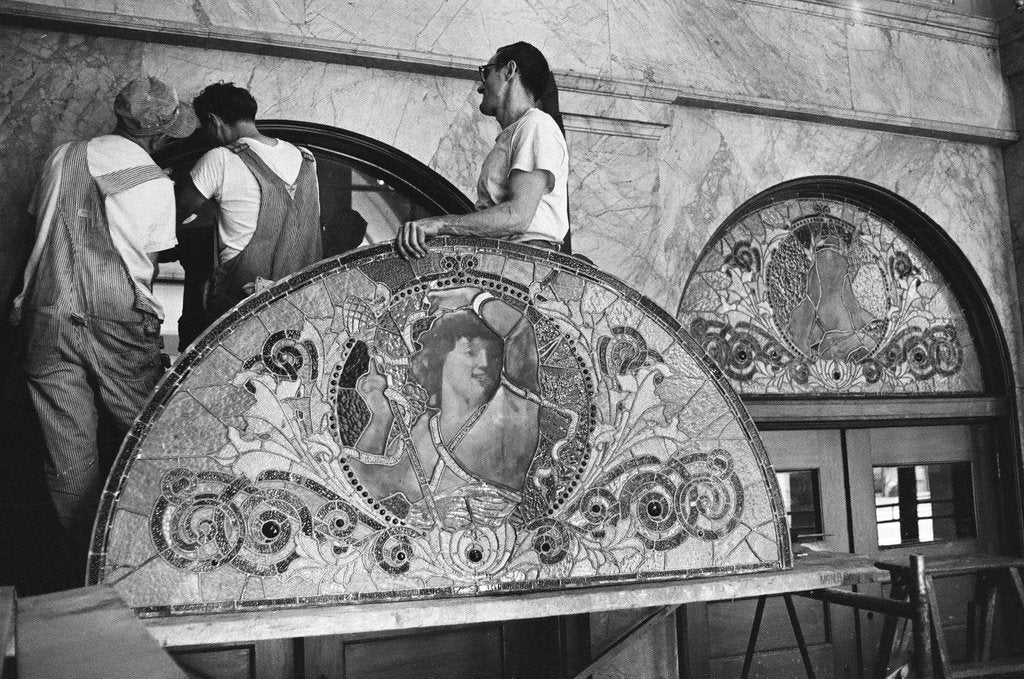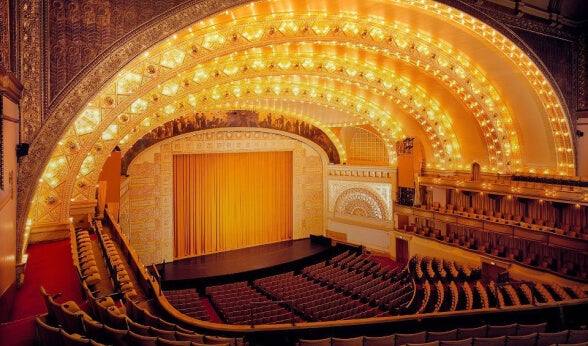The Auditorium is a National Historic Landmark known internationally for its perfect acoustics, innovative architecture, and stunning design. The Auditorium Theatre is the crowning achievement of famed architects Dankmar Adler and Louis Sullivan and opened its doors on December 9, 1889.
Acclaimed architect Frank Lloyd Wright, who worked as a draftsman on the building and theatre, noted that the Auditorium is:
“The greatest room for music and opera in the world — bar none.”
Frank Lloyd Wright, Architect
Adler and Sullivan pushed the limits of modern architecture to make the Auditorium the then-tallest building in Chicago and the first multi-use building ever designed (per request by their benefactor Ferdinand Wythe Peck).
Ferdinand Peck, a wealthy Chicago businessman, incorporated the Chicago Auditorium Association to develop what he envisioned as the world’s largest and grandest theatre, one that would rival such institutions as the Metropolitan Opera House in New York City.
Chicago in the late 1800s was a leading center for political idealism and labor activism. One particularly important demonstration, fighting for an eight-hour work day, occurred at an open market near Des Plaines Ave. and Randolph St. on May 4, 1886. This incident, which became known as the Haymarket Riot, further inspired Ferdinand Peck to create a venue that embodied the democratic ideals that he believed could bring art to all of the people in Chicago.
Peck persuaded many Chicago philanthropists to join the Association, including Marshall Field, Edson Keith, and George Pullman. On December 22, 1886, the Association hired the renowned architectural firm of Dankmar Adler and Louis Sullivan (with whom Peck had worked on the Chicago Opera Festival in 1885) to create the building and the theatre.
 Adler and Sullivan designed a tall Romanesque-style structure with thick load-bearing outer walls. When completed, it was the tallest building in Chicago and the largest building in the country. The construction of the Auditorium cost more than $3,200,000, making it the most expensive building in the city. The Auditorium’s fortress-like exterior echoes the strength and power of its purpose. The simplicity and boldness of the exterior is contrasted with the intricate detail and design of the theatre’s interior, which is lavishly decorated with marble mosaics, art glass, murals and plaster reliefs in organic ornamentation.
Adler and Sullivan designed a tall Romanesque-style structure with thick load-bearing outer walls. When completed, it was the tallest building in Chicago and the largest building in the country. The construction of the Auditorium cost more than $3,200,000, making it the most expensive building in the city. The Auditorium’s fortress-like exterior echoes the strength and power of its purpose. The simplicity and boldness of the exterior is contrasted with the intricate detail and design of the theatre’s interior, which is lavishly decorated with marble mosaics, art glass, murals and plaster reliefs in organic ornamentation.
Excavation began on January 28, 1887, and the Auditorium Theatre officially opened in December 1889.The Auditorium Building’s design included a 4,200 seat auditorium, originally intended primarily for the production of opera, surrounded by over 130 offices; a first-class, 400-room hotel, a bar, and restaurants.
Though the Auditorium opened to immense critical acclaim, what began as a masterfully-designed opera house that sprang from the minds of geniuses gradually fell into disrepair. Although the theatre remained open throughout the Great Depression, it eventually closed down entirely during the 1940s, 1950s, and most of the 1960s. In 1967, a brilliantly restored theatre reopened to the public with a special performance by the New York City Ballet, performing George Balanchine’s A Midsummer Night’s Dream. Through the valiant efforts of one audacious woman, Mrs. Beatrice T. Spachner, and a group of dedicated civic leaders, an independent council was formed to raise funds to restore the theatre to its original splendor. Thanks to their efforts, the theatre reopened in October 1967.

Thanks to multiple restoration and conservation projects, visitors today can enjoy the radiant 24-karat gold-leafed ceiling arches, hundreds of Sullivan’s beautifully restored intricate stencil patterns, ornate gilded and bas-relief designs, murals by Charles Holloway and Albert Fleury, and endless floor and wall mosaics.
For 135 years, the Auditorium Theatre has evolved. While the theatre’s programming has adapted and grown, it has always remained dedicated to providing the highest quality of artistic experiences while preserving the storied principles upon which it was founded.
Throughout its history, the Auditorium has hosted countless dance companies, musicians, speakers, and events.
- Former presidents including Theodore Roosevelt, William McKinley, Bill Clinton,
- Political historical figures like Booker T. Washington, Ida B. Wells, and others
- Rock stars such as Jimi Hendrix, The Doors, Aretha Franklin, Elton John, Stevie Wonder, David Bowie, Miles Davis, Fleetwood Mac, Grateful Dead
- Broadway musicals as well as Broadway icons like Patti Lupone, Bernadette Peters and Sarah Bernhardt
- World-class authors, poets, photographers
- Iconic dance companies like Alvin Ailey American Dance Theater, American Ballet Theatre
Truly, the list goes on and on. Anything you can imagine, it’s happened here most likely.
Steeped in Chicago history, The Auditorium has played a role in the lives of Chicago citizens for over a century and continues to cultivate a theatre for the people.

Quick facts:
- Sullivan was one of ten architects chosen to design a major structure for the “White City,” the World’s Columbian Exposition, held in Chicago in 1893
- After Adler left the firm in 1895, Sullivan continued to design buildings, including Chicago’s State Street Carson Pirie Scott department store, the Gage Building, the Bayard Building in New York, Holy Trinity Russian Orthodox Church, and the Krause Music Store, among others.
- Sullivan was considered one of the most influential architects and he is most known for his philosophy “form should always follow function.”
- Frank Lloyd Wright was hired as a young draftsman by the Adler and Sullivan firm in 1888
- One of the highlights of the Auditorium Theatre is its versatility. The theatre was designed with multiple elements that allowed the theatre to change size, shape, and purpose. This included a reducing curtain, temporary floor, movable ceiling panels, expanding seating capacity, hydraulic lifts, compression and expansion, air ventilation system, and electric lighting
- The Auditorium was one of the first buildings to be wired with electricity at the time of its construction
- There are 55,000,000 mosaic tiles in the building
- The acoustics even from the highest row of the top gallery, audiences can clearly hear an unamplified voice from the stage are based on synagogues, roman and Greek theaters, and John Scott Russell’s theory of isacoustic curve
- The Auditorium is filled with art everywhere you look. The theatre houses lavish mosaics, murals, plaster casts, stencils, art glass, and iron casts. Louis Sullivan’s ornamentation and designs are all inspired by natural forms.
- The Auditorium Building’s art glass was designed and created by the firm of George Healy and Louis Millet. Six arched art glass lunettes are located above the doors leading from the box office entryway into the main lobby. An early source describes the inspiration of the lunettes as the allegorical figures of Wisdom, Oratory, Drama, Music, Poetry, and Dance, representing the forms of art that the theatre’s founders hoped would be performed on its stage.
